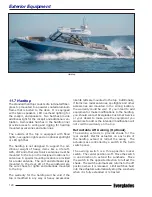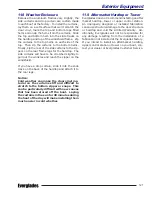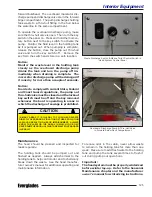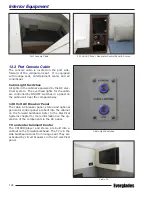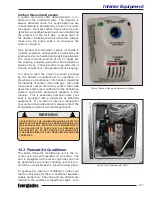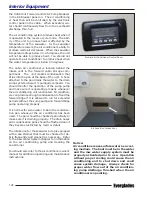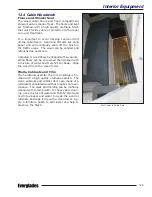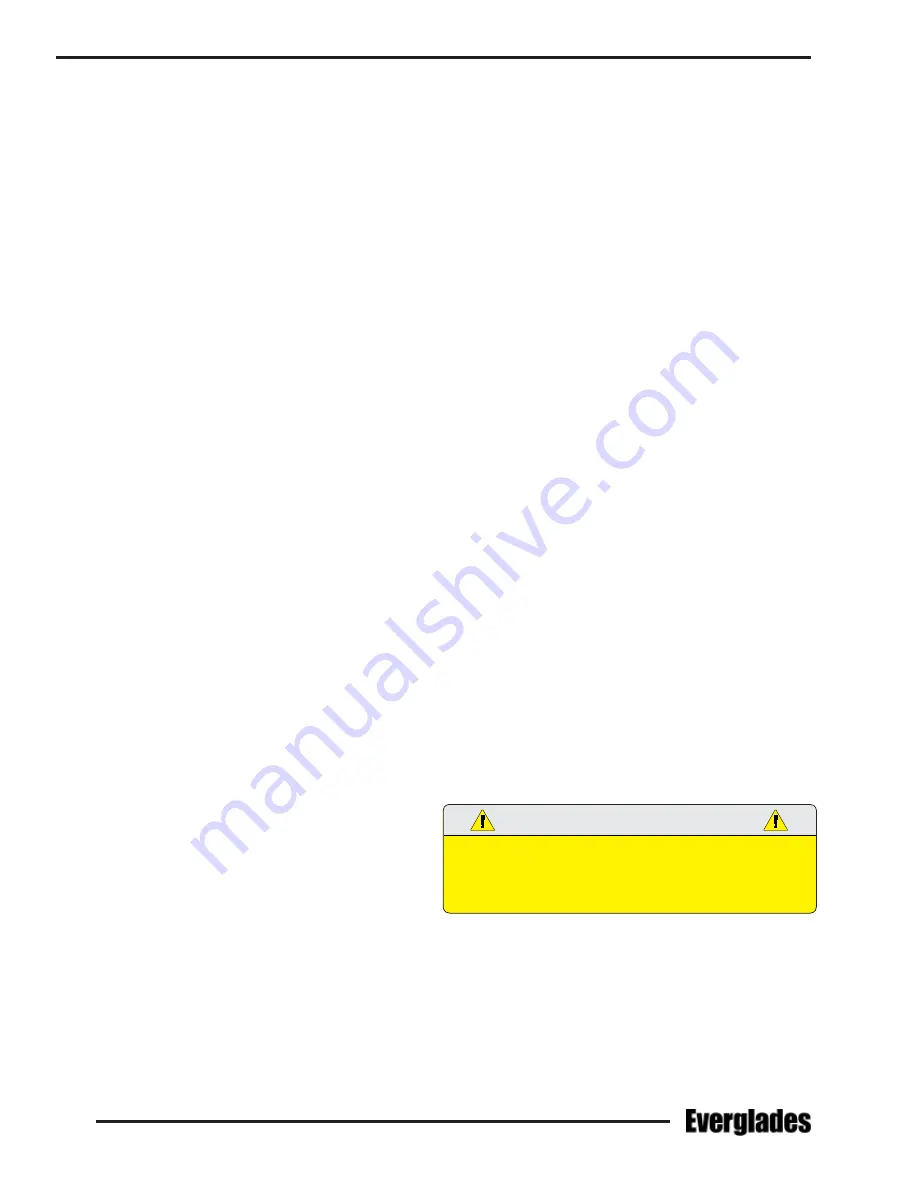
132
Routine Maintenance
The anodes are less noble than copper based
alloys, stainless steel and aluminum. They will
deteriorate first, protecting the more noble un
-
derwater hardware against galvanic corrosion.
They must be monitored if the boat is to be left
in the water. Anodes should be checked monthly
and changed when they are 75% of their original
size. When replacing the anodes, make sure the
contact surfaces are clean, shiny metal and free of
paint and corrosion. Never paint over the anode.
Boats stored in saltwater will normally need to
have the anodes replaced every 6 months to
one year. Anodes requiring replacement more
frequently may indicate a stray current problem
within the boat or at the slip or marina. Anodes
that do not need to be replaced after one year may
not be providing the proper protection. Loose or
low quality anodes could be the problem. Contact
your dealer or Everglades Customer Service for
the proper size and type of anodes to be used and
the specific installation procedure.
There are 2 anodes on Yamaha engines. There is
a large anode on the bottom of the clamp bracket
and another anode on the anti-cavitation plate,
above the propeller. There are also anodes in the
fresh water cooling system for the generator. Refer
to the engine and generator owner’s manuals for
additional information on the location and type of
anodes on your outboard engines and generator.
Fiberglass Gel coat
Normal maintenance requires only washing with
mild soap and water. A stiff brush can be used
on the nonskid areas. Kerosene or commercially
prepared products will remove oil and tar which
could be a problem on trailered boats. Harsh abra-
sive and chemical cleaners are not recommended
because they can damage or dull the gel coat,
reducing its life and making it more susceptible
to stains. When the boat is used in saltwater, it
should be washed thoroughly with soap and water
after each use.
At least once a season, wash and wax all exposed
fiberglass surfaces. Use a high quality automotive
or boat wax. Follow the procedure recommended
by the wax manufacturer. The washing and wax-
ing of your boat will have the same beneficial
effects as they have on an automobile finish.
The wax will fill minute scratches and pores thus
helping to prevent soiling and will extend the life
of the gel coat or paint.
After the boat is exposed to the direct sunlight for
a period of time, the gel coat or painted surfaces
tend to fade, dull or chalk. A heavier buffing is
required to bring the finish back to its original
luster. For power cleaning use a light cleaner. To
clean the boat by hand, use a heavier automotive
cleaner. Before cleaning the surfaces, read the
instructions given with the cleaner. After cleaning
the surfaces, apply wax and polish all fiberglass
surfaces except the nonskid areas.
Avoid the following on gelcoat surfaces:
• Do not use plastic or other nonporous (non-
breathable) materials to cover gelcoat surfac-
es. Trapped moisture from condensation can
cause gelcoat damage. Shrink wrap storage
covers must be properly ventilated, including
hull sides.
• Do not use abrasives, bleaches, ammonia,
acids or harsh detergents. See your dealer for
special marine formulations. Harsh abrasive
and chemical cleaners are not recommended
because they can damage or dull the gelcoat,
reducing its life and making it more susceptible
to stains.
• NEVER apply wax or buffing compound to a
gelcoat surface in direct sunlight.
Chalking, stains and minor scratches can be re-
moved in most cases with careful rubbing and
polishing with appropriate compounds or chemi-
cals and is best done by a professional - see your
dealer.
If the fiberglass should become damaged and need
repair, contact your dealer or Everglades Customer
Service for assistance in finding an authorized
repair person to make the repairs.
CAUTION
DO NOT WAx NONskID AReAs As THIs COulD MAke
THeM slIPPeRY AND CONseQueNTlY INCReAse THe
POssIBIlITY OF INJuRY.
Stainless Steel Hardware
When using the boat in saltwater, the hardware
should be washed with soap and water after each
use. When your boat is used in a corrosive envi-
ronment such as saltwater, water with a high sulfur
content or polluted water, the stainless steel will
Summary of Contents for 340 DC
Page 1: ...OWNER S MANUAL 340 DC...
Page 2: ...2 Revision 0 11 07 2018...
Page 14: ...14 NOTES...
Page 22: ...22 NOTES...
Page 25: ...25 Operation...
Page 86: ...86 NOTES...
Page 102: ...102 NOTES...
Page 122: ...122 NOTES...
Page 130: ...130 NOTES...
Page 149: ...149 MAINTENANCE LOG Appendix B Hours Date Dealer Service Repairs...
Page 150: ...150 Maintenance Log Hours Date Dealer Service Repairs...
Page 151: ...151 Maintenance Log Hours Date Dealer Service Repairs...
Page 152: ...152 Maintenance Log Hours Date Dealer Service Repairs...
Page 153: ...153 Maintenance Log Hours Date Dealer Service Repairs...
Page 154: ...154 Maintenance Log Hours Date Dealer Service Repairs...
Page 155: ...155 Appendix C BOATING ACCIDENT REPORT...
Page 156: ...156 Boating Accident Report...
Page 157: ...157 Boating Accident Report...
Page 158: ...158 NOTES...
Page 160: ...160 NOTES...
Page 167: ...CAUSE AND SOLUTION...



